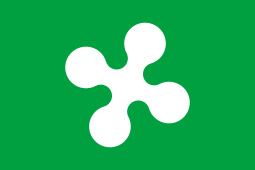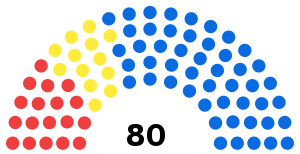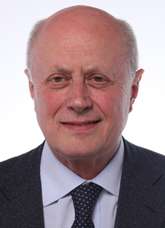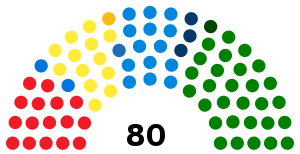Politics of Lombardy
The Politics of Lombardy, Italy, takes place in a framework of a semi-presidential representative democracy, whereby the President of the Region is the head of government, and of a pluriform multi-party system. Legislative power is vested in the Regional Council of Lombardy, while executive power is exercised by the Regional Government led by the President, who is directly elected by the people. The current Statute, which regulates the functioning of the regional institutions, has been in force since 2008.
 |
|---|
| This article is part of a series on the politics and government of Lombardy |
|
Prior to the rise of Fascism, most of the deputies elected in Lombardy were part of the liberal establishment (see Historical Right, Historical Left and Liberals), which governed Italy for decades. Lombardy was also the birthplace of the Italian Workers' Party, forerunner of the Italian Socialist Party, and its eastern and northern provinces were an early stronghold of the Italian People's Party. In the 1924 general election, which led Italy to dictatorship, Lombardy was one of the few regions, along with Veneto and Piedmont, which did not return an absolute majority to the National Fascist Party. After World War II Lombardy became a stronghold of the Christian Democracy, since the 1980s in association with the Italian Socialist Party, which was especially strong in Milan.[1]
Traditionally, Lombardy gives centrist results in elections, reflecting its strong middle class. The Communists and their successors – the Democratic Party of the Left, the Democrats of the Left and the present-day Democratic Party – never prevailed.[1] In the 1980s Lombardy saw the organisation of a new regionalist party, the Lega Lombarda–Lega Nord (LL–LN).
Lombardy is now a stronghold of the "centre-right coalition" composed of the LN and the liberal conservative Forza Italia (FI), founded by Lombard entrepreneur Silvio Berlusconi. The coalition, which was joined by the LN in 2000, has governed the region since 1995, under three Presidents, Roberto Formigoni (CDU/FI/PdL), Roberto Maroni (LL–LN) and Attilio Fontana (LL–LN).
On 22 October 2017 an autonomy referendum took place in Lombardy: 38.3% of Lombards participated and 95.3% voted "yes".
Legislative branch

Centre-right (49)
Centre-left (18)
M5S (13)
The Regional Council of Lombardy is composed of 80 members. 64 councillors are elected in provincial constituencies by proportional representation using the largest remainder method with a Droop quota and open lists, while 16 councillors (elected in a general ticket) come from a "regional list", including the President-elect. One seat is reserved for the candidate who comes second. If a coalition wins more than 50% of the total seats in the Council with PR, as happened during the 2000 election, only 8 candidates from the regional list will be chosen and the number of those elected in provincial constituencies will be 72. If the winning coalition receives less than 50% of votes, as happened during the 1995 election, special seats are added to the Council to ensure a large majority for the President's coalition.[2][3][4]
The Council is elected for a five-year term, but, if the President suffers a vote of no confidence, resigns or dies, under the simul stabunt, simul cadent clause introduced in 1999 (literally they will stand together or they will fall together), also the Council is dissolved and a snap election is called.[5][6]
2018–2023 composition
| Distribution of Seats in the Regional Council | ||
|---|---|---|
| Political Group | 2018 | Now |
| Lega Lombarda–Lega Nord | 29 | 29 |
| Democratic Party | 16 | 16 |
| Forza Italia | 14 | 14 |
| Five Star Movement | 13 | 13 |
| Brothers of Italy | 3 | 3 |
| Gori List | 2 | 2 |
| Fontana List | 1 | 1 |
| Us with Italy | 1 | 1 |
| Energies for Italy | 1 | 1 |
Source: Regional Council of Lombardy
Executive branch

The Regional Cabinet (Giunta Regionale) is presided by the President of the Region (Presidente della Regione), who is elected for a five-year term, and is currently composed by 16 members: the President and 15 regional ministers (Assessori, literally "aldermen"), including a Vice President (Vice Presidente), while 4 under-secretaries (Sottosegretari) help the President but have not right of vote when the cabinet meets.[7]
Current composition
| Party | Members | ||
|---|---|---|---|
| Lega Nord | LN | President and 9 ministers | |
| Forza Italia | FI | 4 ministers | |
| Brothers of Italy | FdI | 2 ministers | |
| Popular Lombardy | LP | 1 minister | |
| Minister | Party | Delegate for | Province | |
|---|---|---|---|---|
| Fabrizio Sala | FI | Vice president, research, university, export and internationalization | MB | |
| Davide Caparini | LN | Finance and simplification | BS | |
| Massimo Sertori | LN | Local government, mountains and small municipalities | SO | |
| Claudia Terzi | LN | Infrastructures, transports and sustainable mobility | BG | |
| Melania De Nichilo Rizzoli | FI | Public instruction and labour | MI | |
| Silvia Piani | LN | Family, parenthood and equal opportunities | PV | |
| Stefano Bolognini | LN | Social policies, social housing and disabilities | MI | |
| Riccardo De Corato | FdI | Public security | MI | |
| Martina Cambiaghi | LN | Youth and sport | MB | |
| Alessandro Mattinzoli | FI | Economic development | BS | |
| Pietro Foroni | LN | Territory and civil protection | LO | |
| Lara Magoni | FdI | Tourism, marketing and fashion | BG | |
| Giulio Gallera | FI | Healthcare and welfare | MI | |
| Stefano Bruno Galli | LN | Autonomy and cultural heritage | MI | |
| Fabio Rolfi | LN | Agricolture, food policies and green systems | BS | |
| Raffaele Cattaneo | LP | Environment and climate | VA | |
List of Presidents
The current President of Lombardy is Attilio Fontana, who is serving for his first term after winning the 2018 regional election.
| President | Term of office | Party | Administration | Coalition | Legislature | |||
|---|---|---|---|---|---|---|---|---|
| Duration in years, months and days | ||||||||
| Presidents elected by the Regional Council (1970–1995) | ||||||||
| 1 |  |
Piero Bassetti (Born 1928) |
29 July 1970 |
27 June 1974 |
DC | Bassetti | DC • PSI • PSDI • PRI | I (1970) |
| 3 years, 10 months and 30 days | ||||||||
| 2 |  |
Cesare Golfari (1932–1994) |
27 June 1974 |
1 October 1979 |
DC | Golfari I | DC • PSI • PSDI • PRI | |
| Golfari II | DC • PSI • PSDI • PRI | II (1975) | ||||||
| 5 years, 3 months and 5 days | ||||||||
| 3 |  |
Giuseppe Guzzetti (Born 1934) |
1 October 1979 |
17 July 1987 |
DC | Guzzetti I | DC • PSI • PSDI • PRI | |
| Guzzetti II | DC • PSI • PSDI • PRI • PLI | III (1980) | ||||||
| Guzzetti III | DC • PSI • PSDI • PRI • PLI | IV (1985) | ||||||
| 7 years, 9 months and 17 days | ||||||||
| 4 |  |
Bruno Tabacci (Born 1946) |
17 July 1987 |
31 January 1989 |
DC | Tabacci | DC • PSI • PSDI • PRI • PLI | |
| 1 year, 6 months and 15 days | ||||||||
| 5 |  |
Giuseppe Giovenzana (Born 1940) |
31 January 1989 |
12 December 1992 |
DC | Giovenzana I | DC • PSI • PSDI • PRI • PLI | |
| Giovenzana II | DC • PSI • PSDI • PRI • PLI | V (1990) | ||||||
| 3 years, 10 months and 13 days | ||||||||
| 6 |  |
Fiorella Ghilardotti (1946–2005) |
12 December 1992 |
4 June 1994 |
PDS | Ghilardotti | DC • PDS • PSI • FdV • PSDI | |
| 1 year, 5 months and 24 days | ||||||||
| 7 |  |
Paolo Arrigoni (Born 1957) |
4 June 1994 |
27 June 1995 |
LN | Arrigoni | PPI • LN • PDS | |
| 1 year and 24 days | ||||||||
| Directly-elected Presidents (since 1995) | ||||||||
| 8 |  |
Roberto Formigoni (Born 1947) |
27 June 1995 |
18 March 2013 |
CDU | Formigoni I | Pole for Freedoms (FI • AN • CDU • CCD) |
VI (1995) |
| FI | Formigoni II | House of Freedoms (FI • LN • AN • CDU • CCD) |
VII (2000) | |||||
| Formigoni III | House of Freedoms (FI • LN • AN • UDC) |
VIII (2005) | ||||||
| PdL | Formigoni IV | PdL • LN | IX (2010) | |||||
| 17 years, 8 months and 20 days | ||||||||
| 9 |  |
Roberto Maroni (Born 1955) |
18 March 2013 |
26 March 2018 |
LN | Maroni | LN • FI • FdI | X (2013) |
| 5 years and 9 days | ||||||||
| 10 |  |
Attilio Fontana (Born 1952) |
26 March 2018 |
Incumbent | LN | Fontana | LN • FI • FdI | XI (2018) |
| 2 years, 3 months and 1 day | ||||||||
Local government
Provinces
Lombardy is divided in twelve provinces, which are a traditional form of local administration in the region, the first ones being yet established under Habsburg rule by Maria Theresa of Austria in the 18th century. Socialist and Christian-democratic ideas had an early diffusion in quite all the provinces around World War I. After the Fascist parenthesis, left-wing parties found their strongholds in south-eastern agricultural provinces near Emilia, especially in the Province of Mantua, while Christian Democracy obtained high scores in the northern mountainous part of the Region, where nowadays the Lega Lombarda–Lega Nord gets a strong backing.
After the 2014 reform of local authorities the Province of Milan was replaced by the new Metropolitan City of Milan. Since 2014 the president of the province is no more elected directly by citizens, but is chosen by mayors and councilors of the municipalities of the province.
| Province | Inhabitants | President | Party | Election | |
|---|---|---|---|---|---|
| Metropolitan City of Milan (former Province of Milan) |
3,208,509 | Giuseppe Sala (metropolitan mayor) |
Democratic Party | 2016 | |
| Brescia | 1,264,105 | Samuele Alghisi | Democratic Party | 2018 | |
| Bergamo | 1,108,298 | Gianfranco Gafforelli | Popular Civic List | 2018 | |
| Varese | 890,090 | Emanuele Antonelli | Forza Italia | 2018 | |
| Monza and Brianza | 866,076 | Roberto Invernizzi | Democratic Party | 2017 | |
| Como | 599,654 | Fiorenzo Bongiasca | Independent | 2018 | |
| Pavia | 547,926 | Vittorio Poma | Democratic Party | 2016 | |
| Mantua | 412,868 | Beniamino Morselli | Democratic Party | 2016 | |
| Cremona | 360,444 | Davide Viola | Democratic Party | 2018 | |
| Lecco | 339,254 | Claudio Usuelli | Forza Italia | 2018 | |
| Lodi | 229,413 | Francesco Passerini | Lega Lombarda–Lega Nord | 2018 | |
| Sondrio | 181,712 | Elio Moretti | Independent | 2018 | |
Municipalities
Lombardy is also divided in 1,546 comuni (municipalities), which have even more history, having been established in the Middle Ages when they were the main places of government. There are twelve provincial capital cities in Lombardy and twenty-four comuni have more than 40,000 inhabitants, most of which are ruled by the centre-left.
Provincial capitals
| Municipality | Inhabitants | Mayor | Party | Election | |
|---|---|---|---|---|---|
| Milan | 1,345,851 | Giuseppe Sala | Democratic Party | 2016 | |
| Brescia | 196,480 | Emilio Del Bono | Democratic Party | 2018 | |
| Monza | 122,671 | Dario Allevi | Forza Italia | 2017 | |
| Bergamo | 119,381 | Giorgio Gori | Democratic Party | 2019 | |
| Como | 84,495 | Mario Landriscina | Forza Italia | 2017 | |
| Varese | 80,799 | Davide Galimberti | Democratic Party | 2016 | |
| Pavia | 72,576 | Fabrizio Fracassi | Lega Lombarda–Lega Nord | 2019 | |
| Cremona | 71,901 | Gianluca Galimberti | Democratic Party | 2019 | |
| Mantua | 48,671 | Mattia Palazzi | Democratic Party | 2015 | |
| Lecco | 47,999 | Virginio Brivio | Democratic Party | 2015 | |
| Lodi | 44,945 | Sara Casanova | Lega Lombarda–Lega Nord | 2017 | |
| Sondrio | 21,568 | Marco Scaramellini | Lega Lombarda–Lega Nord | 2018 | |
Others with 40,000+ inhabitants
| Municipality | Inhabitants | Mayor | Party | Election | |
|---|---|---|---|---|---|
| Busto Arsizio | 83,106 | Emanuele Antonelli | Forza Italia | 2016 | |
| Sesto San Giovanni | 81,608 | Roberto Di Stefano | Forza Italia | 2017 | |
| Cinisello Balsamo | 75,078 | Giacomo Ghilardi | Lega Lombarda–Lega Nord | 2018 | |
| Vigevano | 63,310 | Andrea Sala | Lega Lombarda–Lega Nord | 2015 | |
| Legnano | 60,262 | Gianbattista Fratus | Lega Lombarda–Lega Nord | 2017 | |
| Gallarate | 53,343 | Andrea Cassani | Lega Lombarda–Lega Nord | 2016 | |
| Rho | 50,434 | Pietro Romano | Democratic Party | 2016 | |
| Cologno Monzese | 47,971 | Angelo Rocchi | Lega Lombarda–Lega Nord | 2015 | |
| Paderno Dugnano | 46,633 | Ezio Casati | Democratic Party | 2019 | |
| Lissone | 44,923 | Concettina Monguzzi | Democratic Party | 2017 | |
| Seregno | 44,651 | Alberto Rossi | Democratic Party | 2018 | |
| Rozzano | 42,475 | Gianni Ferretti | Forza Italia | 2019 | |
| Desio | 41,865 | Roberto Corti | Democratic Party | 2016 | |
Parties and elections
Latest regional election
In the latest regional election, which took place on 4 March 2018, Attilio Fontana of the Lega Lombarda–Lega Nord was elected President of Lombardy with the support of centre-right coalition. The election was paired with the 2018 general election.
 | |||||||||
| Candidates | Votes | % | Seats | Parties | Votes | % | Seats | ||
|---|---|---|---|---|---|---|---|---|---|
| Attilio Fontana | 2,793,370 | 49.75 | 1 | ||||||
| League | 1,553,514 | 29.64 | 28 | ||||||
| Forza Italia | 750,628 | 14.32 | 14 | ||||||
| Brothers of Italy | 190,804 | 3.64 | 3 | ||||||
| Fontana List | 76,637 | 1.46 | 1 | ||||||
| Us with Italy–UDC | 66,355 | 1.26 | 1 | ||||||
| Energies for Lombardy | 27,967 | 0.53 | 1 | ||||||
| Pensioners' Party | 20,259 | 0.38 | – | ||||||
| Total | 2,686,610 | 51.29 | 48 | ||||||
| Giorgio Gori | 1,633,367 | 29.09 | 1 | ||||||
| Democratic Party | 1,008,496 | 19.24 | 15 | ||||||
| Gori List | 158,671 | 3.02 | 2 | ||||||
| More Europe | 108,743 | 2.07 | – | ||||||
| Lombardy for the Autonomies Target | 62,840 | 1.19 | – | ||||||
| Together | 35,071 | 0.66 | – | ||||||
| Popular Civic List | 20,668 | 0.39 | – | ||||||
| Progressive Lombardy | 20,036 | 0.38 | – | ||||||
| Total | 1,414,674 | 26.99 | 17 | ||||||
| Dario Violi | 974,984 | 17.36 | – | Five Star Movement | 933,243 | 17.80 | 13 | ||
| Onorio Rosati | 108,407 | 1.93 | – | Free and Equal | 111,296 | 2.12 | – | ||
| Angela De Rosa | 50,368 | 0.89 | – | CasaPound Italy | 45,416 | 0.86 | – | ||
| Massimo Gatti | 38,194 | 0.68 | – | Left for Lombardy | 35,713 | 0.68 | – | ||
| Giulio Arrighini | 15,791 | 0.28 | – | Great North | 13,769 | 0.26 | – | ||
| Total candidates | 5,614,481 | 100.00 | 2 | Total parties | 5,240,126 | 100.00 | 78 | ||
| Source: Ministry of the Interior – Historical Archive of Elections | |||||||||
References
- Piergiorgio Corbetta; Maria Serena Piretti, Atlante storico-elettorale d'Italia, Zanichelli, Bologna 2009
- "Regional Council of Lombardy – Electoral law". Archived from the original on 2008-06-07. Retrieved 2008-06-09.
- "Regional Council of Lombardy – Scheme for allocation of seats" (PDF). Archived from the original (PDF) on 2010-06-05. Retrieved 2010-02-07.
- Ministry of the Interior – Electoral Archive
- "Regional Council of Lombardy – 1999 Constitutional Law" (PDF). Archived from the original (PDF) on 2009-03-06. Retrieved 2009-03-06.
- "Regional Council of Lombardy – Autonomy Statute". Archived from the original on 2011-07-26. Retrieved 2010-01-09.
- Lombardy Region – Regional Cabinet